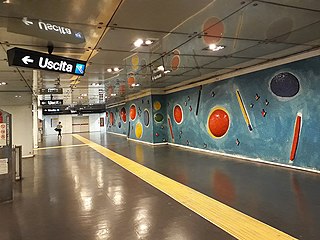
The Naples Metro is a rapid transit system serving the city of Naples, Campania, Italy and some parts of the adjacent comuni of its metropolitan area through Line 11. The system comprises four underground rapid transit lines.
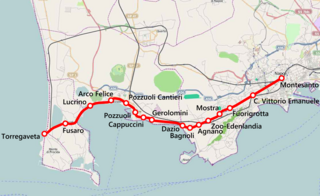
Line 4, mostly known as the Cumana railway is a commuter rail service in Campania, southern Italy, connecting Naples by two separate routes with Torregaveta, near Cuma in the town of Bacoli. It passes through Pozzuoli and the volcanic Campi Flegrei area. The line was built and run by the Società per le Ferrovie Napoletane, founded in 1883, and is now operated by the Ente Autonomo Volturno (EAV) company.

Piscinola, or Piscinola-Marianella, is a northern suburb of Naples, Italy, with a population of ca. 20,000. It is bordered to the north by the Scampia district, north-west with the municipality of Mugnano of Naples, on the west by the Chiaiano district, to the south with the district of San Carlo all'Arena and east with the district Miano.
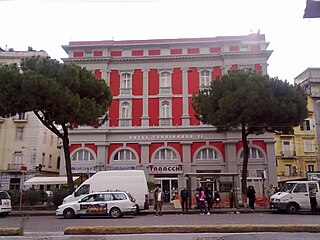
The Ferrovia Alifana is a former railway company of southern Italy. It held public passenger service on the rail line connection Naples to Piedimonte d'Alife. In 2005 it was acquired by the MetroCampania NordEst (MCNE), another public company responsible of passenger transport in northern Campania.

Line 1 is an 18.8-kilometre (11.7 mi) rapid transit line, part of the Naples Metro in Naples, Italy. As of July 2023, Line 1 connects 19 stations. It is operated by Azienda Napoletana Mobilità SpA (ANM). The line has been renamed Metrò dell'Arte reflecting the presence of contemporary art works installed in some of its stations.

Line 2 is an 18.9-kilometre (11.7 mi) commuter rail line, part of the Naples Metro in Naples, Italy. As of January 2024, Line 2 connects 12 stations. It is operated by Trenitalia.
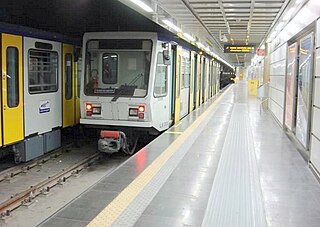
Line 6 is a 2.2-kilometre (1.4 mi) light metro line that forms part of the Naples Metro. It connects 4 stations. The line is currently closed to the public due to low ridership. It has been closed since 2013.
Line 10 is the name of the underground Naples Metro line being built designed to connect the Naples Afragola station of the Rome-Naples high-speed railway with the historic Centre of Naples, with interchanges with Line 1, Line 2, Line 11 and the Circumvesuviana railway. The line itself is designed to be automatically guided (driverless) and connect the municipalities of Afragola, Casavatore, Casoria and Naples, as well as a branch called "Baffo di Arzano" to connect the municipality of Arzano with two stations.

The Rome–Naples high-speed railway line is one of the railways in the Italian high-speed rail network. Initially opened in December 2005, it is the first railway line in Italy to be electrified at 25 kV AC and the first in the world to use ETCS Level 2 in normal rail operations.

The Naples–Salerno high-speed railway line is a link in the Italian high-speed rail network opened in June 2008. The 29-kilometre-long (18 mi) line is one of the new high-speed lines being built to strengthen rail transport system in Italy and in particular freight and passenger transport in Campania. The line is part of Corridor 1 of the European Union's Trans-European high-speed rail network, which connects Berlin and Palermo.
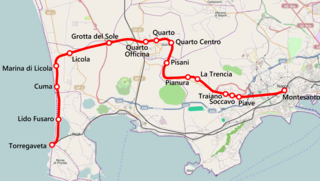
The Circumflegrea railway is a commuter railway line that connects Naples city centre with the northern Phlegraean Fields, a suburban area located west of the city. The line is operated by the Ente Autonomo Volturno (EAV) company.

The Naples tramway network is located within the city and comune of Naples, in the region of Campania, southern Italy. In operation since 1875, the network has waxed and waned in size and vitality over the years, and is now growing once again. It is now 11.8 km (7.3 mi) long, and comprises three routes, known as lines 1, 2 and 4.
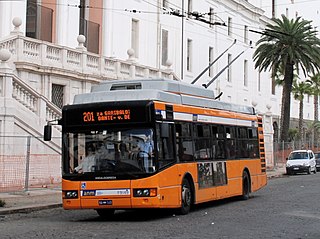
Trolleybuses in Naples provide a portion of the public transport service in the city and comune of Naples, in the region of Campania, southern Italy. From 1964 to 2015, two independent trolleybus systems were in operation, both publicly owned, but only that of Azienda Napoletana Mobilità (ANM) remains in operation. The ANM system opened in 1940, whereas the smaller trolleybus network of Compagnia Trasporti Pubblici di Napoli (CTP) opened in 1964.
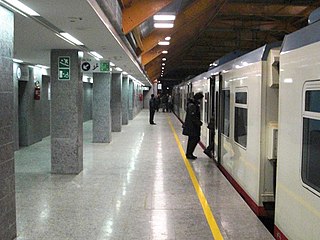
The Bari metropolitan railway service is a commuter rail service in the Italian city Bari. It consists of two lines, joining the central railway station, located in the city centre, with the dormitory suburb San Paolo and with the ″Karol Wojtyła″ Airport and the city of Bitonto.

The S4 is a commuter rail route forming part of the Milan suburban railway service, which converges on the city of Milan, Italy.

The S5 is a commuter railway route forming part of the Milan suburban railway service, which converges on the city of Milan, Italy.
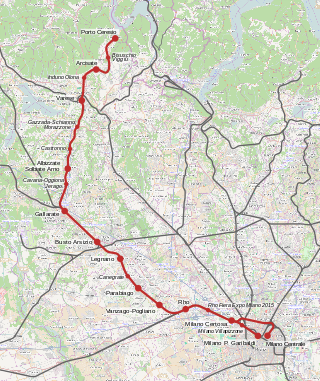
Porto Ceresio–Milan railway is a railway line in Lombardy, Italy. It uses the tracks of the Milan–Arona railway until Gallarate.

Naples Metropolitan Railway service are two independent companies that operate a commuter rail system in Naples. The first one, Trenitalia, operates line 2 from Pozzuoli Solfatara to Gianturco station in East of Naples. The other one, EAV, operates the Circumvesuviana, Cumana, Circumflegrea and MetroCampania NordEst. In Italy, Naples is the only city possessing two independent metropolitan railway service companies.
Di Vittorio will be a station on Line 1 of the Naples Metro and on Line 11 of the railway network managed by EAV. It is located in the Secondigliano district, between Piazza Giuseppe Di Vittorio and Viale Comandante Umberto Maddalena.

The Piscinola Scampia is a station on Line 1 and Line 11 of the Naples Metro and together with Garibaldi is one of the two termini of Line 1.




















